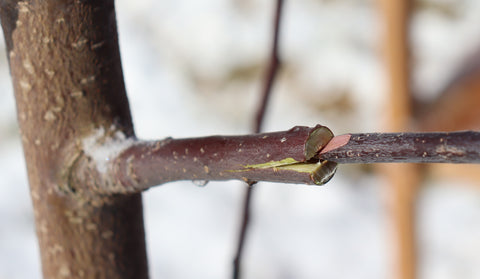
Grafting is taking a scion from a tree with a desirable characteristic and adding it onto another tree. (I know that might still sound like gibberish and doesn't clarify either so I will try to explain it further). If you have a tree that has really good or special apples you can cut a small stick off that tree and attach it to another tree, and that other tree will now grow those same apples. Scion is just simply a fancy name for the stick that you are going to put on your existing tree.
It might sound like just a fun trick, but in fact all named apples trees you are familiar with are grafted. Since many plants are not "true to seed" you can't just plant the seeds from an apple and get the same apple tree to grow. That is why they are all grafted which is much like cloning. (This is also the reason that two trees of the same named variety will not cross pollinate each other). Some of these named varieties of fruit are also slow growing or weak rooted plants, and that is why they are grafted onto specially selected "rootstock". These rootstock trees have desirable growth patterns, disease resistance, etc. So by grafting the two together you will get the best of both plants in your final tree.
There are generally two times in the year when you can complete grafts on your trees and in this case "timing is everything". There are also different techniques to use at different times of the year.
This grafting is done in the early spring, and you want to try and time it just as the trees are coming out of dormancy and the buds on the trees are starting to swell and leaf out. The other half of the timing of this is to ensure your scions are still dormant, so they often need to be collected and stored earlier in the year. I will talk a bit about scion collection a bit later.
I will just discuss one technique from spring grafting called cleft grafting, it is a bit easier for beginners and usually more successful. This technique is also best used on trees that are only 2-4 years old. (When it comes to rejuvenating older trees it becomes much more challenging, and will not be discussed here) It's best to try and ensure your scions are approximately the same diameter as your rootstock/branch you are grafting onto and try to find a main lateral branch down low and close to the trunk of the tree.
First you need to prune off the entire branch you are going to be grafting onto. Then you will make a small cut down the center of the branch, approximately 1cm deep.

In your piece of scion wood you want to cut a skinny wedge that is also approximately 1cm long. You then want to gently insert the wedge into the slit you made into your rootstock tree. (Sometimes you need a small screwdriver or knife to gently open the slit to help inserting the wedge) It is very important to precisely line up the cambium layer of both the root stock and the scion. (The cambium layer is the thin greenish layer underneath the bark, but above the inner wood of the tree). Ideally your scion will be identical size of the branch and you can line up both sides, but if not ensure at least one side if lined up and the scion is not floating in the middle of the wood.

Once you have it securely fit, you want to wrap it gently with parafilm or something similar, to ensure it stays secure and also to close the wound to external elements. The parafilm can remain in place for the entire year until it starts to fall off itself or if applied thickly can be removed after 1 year.

You scion should be pruned to 2 buds only, so that it is not demanding too much resources and easier to support new growth. I also often apply wax to the tips of the scions to prevent them from drying out as well. Be sure to label the branches so you are aware of the varieties you have added to your tree.

If you are successful you should have pretty good growth out of one of the two remaining buds and should know pretty quickly if you were successful.

Your scions must be taken from healthy trees otherwise it's a very easy way to pass an infection or disease to a healthy tree.
Scions should be taken from vigorous one year growth. This can sometimes be harder to find on older mature trees. One year wood is found at the tips of branches and can usually be distinguished by being smoother and shinier that older wood.
It's best to collect it in the late winter or very early in the spring to ensure it is dormant. You can wrap the base of the cuttings in some damp paper and seal it into a plastic Ziploc bag and store it in the fridge until you are going to use it.
Make sure you label your cuttings so you can keep track of the varieties you have.
Please be aware this is an incredibly simple overview, but enough to give it a try. There are many other online resources to learn more about grafting and we also have workshops regularly if you are interesting in knowing more.
I will also add a discussion about late summer- bud grafting at a later time as well.